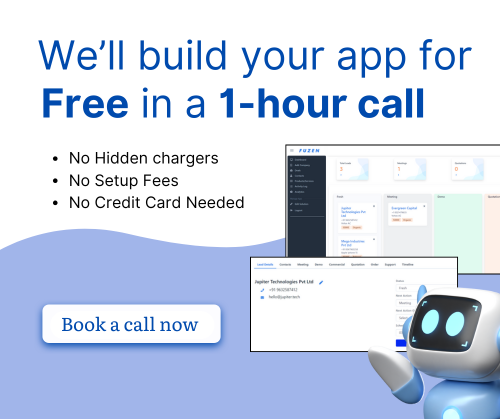9 Best No Code Tools Available To Create Web App
Ever wanted to build apps or create a web app but got stuck on the coding part? No worries!
We’ve got some cool no-code app builders that let you make awesome web apps without the need to write any complicated code. Let's check them out!
But what exactly is a web app? Simply put, it's a software application that runs on web servers, accessible via web browsers.
Understanding web apps
Web apps, or web-based applications, are the backbone of modern online experiences. They eliminate the need for installation and can be accessed from any device with an internet connection. For instance, Software as a Service (SaaS) solutions like CRM tools or email automation platforms fall under this category, enabling seamless user experiences without the hassle of downloads.
Web app examples
The landscape of web applications is vast and varied, catering to a multitude of purposes. Consider the following examples:
- E-commerce Applications: Think giants like Amazon or eBay, facilitating online transactions with ease.
- SaaS Apps: From customer relationship management (CRM) systems to project management tools, SaaS solutions streamline business operations.
- Health and Fitness Apps: Fitness enthusiasts swear by apps like Fitbit or MyFitnessPal for tracking progress and staying motivated.
- Real-Time Communication Apps: In today's remote-friendly world, platforms like Slack and Zoom keep teams connected effortlessly.
No code web app builders to create web app
1. Fuzen
If you're seeking to develop a SaaS app, Fuzen emerges as the ultimate choice. With Fuzen, the possibilities are endless.
You can craft various types of SaaS applications, including CRM systems, accounting management software, email automation tools, and project management platforms.
The process of building your SaaS app with Fuzen is as seamless as it gets. Simply follow these steps:
- Create a robust data structure to organize and manage your app's information effectively.
- Utilize Fuzen's intuitive interface to design and build pages tailored to your specific requirements.
- Establish a streamlined workflow to ensure smooth user experiences and efficient operations.
Pros
- Intuitive platform forbuilding SaaS applications without coding knowledge.
- Flexible: Allows for customization and adaptation to various business needs.
- Scalable: Capable of growing alongside the business without significant technical overhead.
Cons
- Not suitable for building websites and mobile applications.
Pricing: Fuzen offers a free plan while the paid plan starts at $19 per month.
2. Shopify

If your ambition is to establish an e-commerce empire, look no further thanShopify. Shopify simplifies the process of building an online store, offering a plethora of features and functionalities.
Whether you're a budding entrepreneur or a seasoned business owner, Shopify caters to all levels of expertise.
With Shopify's user-friendly interface and comprehensive tools, you can effortlessly bring your e-commerce vision to life.
Pros
- Robust e-commerce platform with a wide range of features and integrations.
- User-friendly interface suitable for beginners and experienced users alike.
- A scalable solution capable of supporting businesses of all sizes.
Cons
- Transaction fees may apply, especially for users not using Shopify Payments.
- Customization options may be limited for highly unique or specialized requirements.
Pricing: Shopify offers multiple pricing plans starting from $29 per month for basic features up to $299 per month for advanced features and support.
3. Webflow

Webflow stands out as a visual editor platform tailored for designing and building stunning websites without the need for coding. With its intuitive interface and powerful design tools, Webflow empowers users to create powerful apps and professional-grade websites with ease.
Whether you're a seasoned web designer or a novice, Webflow provides the flexibility and functionality to bring your creative vision to life. From customizable templates to responsive layouts, Webflow offers a comprehensive suite of features to cater to a diverse range of web design needs.
Pros
- Powerful visual editor for designing and building websites without coding.
- Extensive customization options with control over every aspect of the design.
- Responsive design capabilities for creating mobile-friendly websites.
Cons
- Learning curve for users new to web design concepts and terminology.
- Limited e-commerce functionality compared to dedicated e-commerce platforms like Shopify.
Pricing: Webflow offers multiple pricing plans starting from $12 per month for basic features up to $36 per month for advanced features and hosting.
4. Stacker

Stacker is revolutionizing the way customer portals and internal tools are built, leveraging the power of your data. With Stacker, you can seamlessly integrate your existing data sources to create personalized customer portals and streamline internal workflows.
Whether you’re managing customer relationships or optimizing internal processes, Stacker provides the tools and capabilities to build powerful apps that enhance efficiency and productivity. By harnessing the data at your disposal, Stacker empowers you to build customized solutions tailored to your unique requirements.
Pros
- Simplifies the creation of customer portals and internal tools using existing data sources.
- Customizable templates and components for tailoring solutions to specific needs.
- Integration with popular data sources and APIs for seamless data access.
Cons
- Limited flexibility compared to fully custom-built solutions.
- May require additional setup and configuration for complex data structures.
Pricing: Stacker offers multiple pricing plans starting from $49 per month for basic features up to $249 per month for advanced features and support.
5. Xano

Xano emerges as the premier tool to build backends without the need for coding, revolutionizing the way web apps are developed.
With its intuitive interface and powerful features, Xano enables users to create robust backend systems in a fraction of the time traditionally required.
Whether you're a seasoned developer or a non-technical entrepreneur, Xano empowers you to harness the full potential of backend development without getting bogged down by complex code.
Pros
- Fast and efficient backend development without coding.
- Real-time database and API capabilities for seamless integration with web apps.
- Scalable solution suitable for a wide range of applications and industries.
Cons
- Limited control compared to custom-coded backend solutions.
- May require some learning curve for users new to backend development concepts.
Pricing: Xano offers multiple pricing plans starting from $99 per month for basic features up to $499 per month for advanced features and support.
6. Zapier

Next, we have Zapier, a unique platform that focuses on automating workflows by connecting different apps and services. While not specifically designed for building web apps from scratch, Zapier plays a crucial role in streamlining processes and enhancing productivity. With its vast library of integrations and automation features, Zapier allows users to create custom workflows without any coding knowledge. While Zapier’s free plan offers limited functionality, its paid plans unlock access to more advanced features and integrations.
Zapier is ideal for individuals, businesses, and organizations looking to automate workflows and streamline processes across multiple applications and services. It caters to a wide range of users, from freelancers and small teams to large enterprises with complex automation needs.
Pros
- Simplifies workflow automation by connecting various apps and services.
- Extensive library of integrations to choose from.
- Free plan available with options to upgrade for more advanced features.
Cons
- Not specifically designed for building web apps from scratch.
- Free plan may have limitations compared to paid options
Pricing: Zapier offers a free plan, with its Professional plan starting at $19.99/month, the Team plan at $69/month, and Enterprise plans available with custom pricing.
7. Knack

Then, we have Knack, a no-code platform that focuses on building custom database applications. With Knack, users can create sophisticated web apps with complex data structures without any coding knowledge. Knack’s intuitive interface and drag-and-drop builder make it easy to design and customize applications to suit specific requirements. While Knack’s free plan offers basic functionality, its paid plans provide access to advanced features and additional support options.
Perfect for businesses and organizations that require custom database applications to manage their data and workflows.
Pros
- Specializes in building custom database applications with complex data structures.
- Intuitive interface and drag-and-drop builder for easy customization.
- Free plan available with options to upgrade for more advanced features.
Cons
- May have a learning curve for users unfamiliar with database concepts.
- Free plan limitations compared to paid options.
Pricing: Knack's pricing begins with the Starter plan at $39/month, followed by the Pro plan at $79/month, the Corporate plan at $179/month, and Enterprise plans with custom pricing.
8. Bubble

Bubble is another powerhouse in the realm of no-code development, providing a comprehensive platform for building fully functional web applications without writing code. With Bubble’s visual editor and workflow builder, users can create sophisticated web apps with complex functionality without writing code. Bubble’s extensive plugin ecosystem further enhances its capabilities, allowing users to integrate with third-party services and add advanced features to their apps. While Bubble’s free plan offers basic functionality, users can upgrade to access additional features and remove Bubble branding.
Suitable for entrepreneurs, startups, and businesses looking to build complex web applications with advanced functionality.
Pros
- Comprehensive platform for developing web applications without code.
- Visual editor and workflow builder for designing complex apps.
- Extensive plugin ecosystem for integrating with third-party services.
Cons
- Free plan limitations compared to paid options.
- May have a learning curve for users new to the platform.
Pricing: Bubble provides a free plan, with the Personal plan costing $29/month, the Professional plan $129/month, the Production plan $429/month, and Enterprise plans priced individually.
9. Appy Pie

Last but not least, we have Appy Pie, a versatile platform that enables users to create mobile apps, websites, and chatbots without any coding knowledge. With its intuitive interface and drag-and-drop builder, Appy Pie makes it easy to bring your ideas to life. Whether you’re building a mobile app for your business or creating a website for your portfolio, Appy Pie offers a range of templates and customization options to suit your needs. While Appy Pie’s free plan provides basic functionality, users can upgrade to access premium features and remove branding.
Appy Pie is ideal for entrepreneurs, small businesses, and individuals looking to create mobile apps, websites, and chatbots without coding knowledge.
Pros
- Versatile platform for building mobile apps, websites, and chatbots.
- Intuitive interface and drag-and-drop builder for easy customization.
- Offers a range of templates and customization options.
Cons
- Free plan limitations compared to paid options.
- May not offer as many advanced features as specialized platforms.
Pricing: Appy Pie also has a free plan, with the Basic plan at $16/month, the Gold plan at $36/month, and the Platinum plan at $60/month.
Conclusion
Each of these no-code web app builders helps you build apps with unique features and capabilities that cater to different needs and preferences.
Whether you prioritize scalability, flexibility, ease of use, or specific functionalities, there’s a tool on this list that can help you bring your web app idea to life without the need for coding.
Explore these options, find the one that aligns best with your requirements, and embark on your journey to digital innovation with confidence.

